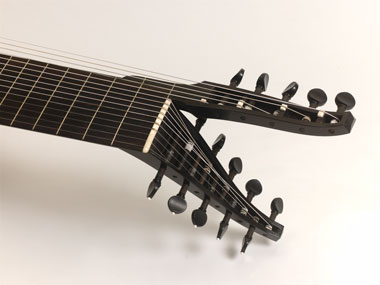About the Liuto forte
Early History
- Lute and guitar – a dilemma?
- Lute and guitar in the 20th century
- Why the lute died out
- Original instruments – original sound?
- The stringing of historical lutes
- Rift between guitar and lute
- Distinctions in sound
- Methods of guitar and lute construction
- The guitar’s limited bass range
About the Liuto forte
- A Lute for the 21st century
- “Guitar-lute“ or “authentic“ lute
- Historical Liuti forti
- Single or double strings?
- Liuto forte sound
- Liuto forte stringing
- Fingertips or nails?
- The belly
- Fine tuning
- The rose
- Fixed or tied-on frets?
- Tuning pegs
- The nut
- The fingerboard
- The bridge
- Playing position
- Playing technique
- Prospects
The Guitar’s limited Bass Range
The limited range of the guitar’s bass strings forces guitarists to make concessions in correct voice leading and spurs them on to record achievements in leaping and stretching and stopping in all positions.1 Since all the bass notes apart from E, A and d have to be stopped, it is not possible to keep up real contrary motion in the counterpoint for long stretches unbroken. This is not solved by acrobatic dashing up and down the fingerboard. The musical listener is often therefore left more satisfied by a guitar duo.

A guitar tuned to an E minor chord with additional deep D and/or B natural in the bass would be doubtlessly better equipped. Most of the guitars, however, which have been fitted for this purpose with 8 or more strings, have not only little visual elegance, but have often so much ambient resonance as to distract the player’s attention with constant dampening of unwanted sympathetic ringing. This phenomenon is apparent on lute instruments as well, but is never as disturbing as it is on a guitar, whose sympathetic self-vibrating of up to 10 strings, in the absence of any soundpost co-ordinating top and back, can hardly be harmonised.
Over and above such aesthetic reservations, it is the soundboard construction which limits the profitable extension of the guitar’s range into the depths. The dark character prevents all tones deeper than D from blending at all with the descant – and if one wanted to brighten them up, the Driving Area (Sound Ellipse) would have to be diminished, taking the high strings back to the sound of the “classical” period guitar.
1 The greatest obstacle for guitarists playing baroque lute repertoire on the Spanish guitar is not the lack of strings below the E, but the missing low G and F strings. The Austrian musicologist Kiesewetter suggested a tuning in 1831, which added G & F strings between the A & E, and extended down to contra A.



